Hybrid Spectrum Sensing Using MD and ED for Cognitive Radio Networks
Abstract
:1. Introduction
2. Background
3. System Model of Matched Detector (MD) and Cooperative Spectrum Sensing (CSS)
3.1. Spectrum Sensing Using the Matched Detector for Rayleigh Fading Channel
3.2. Spectrum Sensing Using Cooperative Spectrum Sensing (CSS)
4. Proposed Hybrid Model
- Monte Carlo simulations are used to iterate the maximum possible outcomes of the proposed HD to sense the channel;
- There are two algorithms implemented under HD, namely the matched detector (MD) and energy detector (ED). Based on the user’s demand, one can select MD or ED as in function of whether the PU’s information is available, how much complexity is required, and the worst SNR region operation;
- The Rayleigh channel model was developed for HD, where h is the unknown channel coefficient for MD. To determine h, normalisation is applied;
- The threshold is a function of the probability of a false alarm, calculated from N degrees of freedom in the inverse chi-square distribution, where N = τ (available sensing time) x fs (sampling frequency);
- Under non-CSS and CSS environments, HD is analysed. CSS is implemented for the number of cooperative users (4) using OR, AND, and Majority rule algorithms. The simulation and theoretical results are compared for all scenarios. CSS overcomes the problem of single CR user inability in the detection of a hidden PU signal;
- The targeted parameters at −20 dB (worst SNR range) which are used for operating digital TV, a probability of detection of 0.9, and a probability of false alarm of 0.1 [14], are the focus herein. IEEE 802.22 WRAN developed these parameters to access the TV broadcast channels without interfering with licensed (primary) users.
5. Results and Discussion
5.1. Performance Analysis of HD for Non-CSS
5.2. Performance Analysis of HD for CSS
6. Conclusions
Author Contributions
Funding
Institutional Review Board Statement
Informed Consent Statement
Data Availability Statement
Conflicts of Interest
References
- Federal Communications Commission. Spectrum Policy Task Force Report, FCC 02-155; Federal Communications Commission: Washington, DC, USA, 2002. [Google Scholar]
- Wyglinski, A.M.; Nekovee, M.; Hou, Y.T. Cognitive Radio Communications and Networks: Principles and Practice; Elsevier: Amsterdam, The Netherlands, 2010. [Google Scholar]
- Mitola, J. Cognitive Radio: An Integrated Agent Architecture for a Software-Defined Radio. Ph.D. Thesis, Royal Institute of Technology (KTH), Stockholm, Sweden, 2000. [Google Scholar]
- Mitola, J.; Maguire, G.Q. Cognitive Radios: Making Software Radios More Personal. IEEE Pers. Commun. 1999, 6, 13–18. [Google Scholar] [CrossRef] [Green Version]
- Haykin, S. Cognitive radio: Brain-empowered wireless communications. IEEE J. Sel. Areas Commun. 2005, 23, 201–220. [Google Scholar] [CrossRef]
- Akyildiz, I.F.; Lee, W.-Y.; Vuran, M.C.; Mohanty, S. A survey on spectrum management in cognitive radio networks. IEEE Commun. Mag. 2008, 46, 40–48. [Google Scholar] [CrossRef] [Green Version]
- Alom, M.Z.; Godder, T.K.; Morshed, M.N. A survey of spectrum sensing techniques in Cognitive Radio network. In Proceedings of the International Conference on Advances in Electrical Engineering (ICAEE), Dhaka, Bangladesh, 17–19 December 2015; pp. 161–164. [Google Scholar]
- Bani, K.; Kulkarni, V. Simulink Based Estimation of Spectrum Sensing Techniques in Cognitive Radio. In Innovations in Electronics and Communication Engineering; Lecture notes in Networks & Systems; Springer: Singapore, 2017; Chapter 41. [Google Scholar]
- Liang, Y.C.; Zeng, Y.H.; Peh, E.; Hoang, A.T. Sensing–throughput tradeoff for cognitive radio networks. IEEE Trans. Wirel. Commun. 2008, 7, 1326–1337. [Google Scholar] [CrossRef]
- Urkowitz, H. Energy detection of unknown deterministic signals. Proc. IEEE 1967, 55, 523–531. [Google Scholar] [CrossRef]
- Digham, F.; Alouini, M.-S.; Simon, M. On the energy detection of unknown signals over fading channels. In Proceedings of the IEEE International Conference on Communications, Paris, France, 20–24 June 2004. [Google Scholar] [CrossRef]
- Kim, S.; Lee, J.; Wang, H.N.; Hong, D. Sensing performance of energy detector with correlated multiple antennas. IEEE Signal Process. Lett. 2009, 16, 671–674. [Google Scholar]
- Bagwari, A.; Singh, B. Comparative performance evaluation of Spectrum Sensing Techniques for Cognitive Radio Networks. In Proceedings of the Fourth International Conference on Computational Intelligence and Communication Networks, IEEE, Washington, DC, USA, 24–26 July 2012. [Google Scholar]
- Yang, G.; Wang, J.; Luo, J.; Wen, O.Y.; Li, H.; Li, Q.; Li, S. Cooperative Spectrum Sensing in Heterogeneous Cognitive Radio Networks Based on Normalized Energy Detection. IEEE Trans. Veh. Technol. 2015, 65, 1452–1463. [Google Scholar] [CrossRef]
- Cordeiro, C.; Challapali, K.; Birru, D.; Sai Shankar, N. IEEE 802.22: An Introduction to the First Wireless Standard based on Cognitive Radios. J. Commun. 2006, 1, 38–47. [Google Scholar] [CrossRef] [Green Version]
- Akyildiz, I.F.; Lo, B.F.; Balakrishnan, R. Cooperative spectrum sensing in cognitive radio networks: A survey. Phys. Commun. 2011, 4, 40–62. [Google Scholar] [CrossRef]
- Abed, H.S.; Abdullah, H.N. Improvement of spectrum sensing performance in cognitive radio using modified hybrid sensing method. Acta Polytech. 2022, 62, 228–237. [Google Scholar] [CrossRef]
- Rajaguru, R.; Devi, K.V.; Marichamy, P. A hybrid spectrum sensing approach to select suitable spectrum band for cognitive users. Comput. Netw. 2020, 180, 107387. [Google Scholar] [CrossRef]
- Abdullah, H.; Dawood, Z.O.; Abdelkareem, A.E.; Abed, H.S. Complexity reduction of cyclostationary sensing technique using improved hybrid sensing method. Acta Polytech. 2020, 60, 279–287. [Google Scholar] [CrossRef]
- Khobragade, A.S.; Raut, R.D. Hybrid Spectrum Sensing Method for Cognitive Radio. Int. J. Electr. Comput. Eng. (IJECE) 2017, 7, 2683–2695. [Google Scholar] [CrossRef]
- Zhang, X.; Chai, R.; Gao, F. Matched filter-based spectrum sensing and power level detection for cognitive radio network. In Proceedings of the Global Conference on Signal and Information Processing, Atlanta, GA, USA, 3–5 December 2014; pp. 1267–1270. [Google Scholar]
- Siranjeevi, M.; Karthikeyan, K.V. A study analysis of cooperative spectrum sensing in cognitive radio network. In Proceedings of the Second International Conference on Science Technology Engineering and Management (ICONSTEM), Chennai, India, 30–31 March 2016; pp. 551–555. [Google Scholar]
- Abdelrassoul, R.; Fathy, E.; Zaghloul, M.S. Comparative Study of Spectrum Sensing for Cognitive Radio System Using Energy Detection over Different Channels. In Proceedings of the 2016 World Symposium on Computer Applications & Research (WSCAR), Cairo, Egypt, 12–14 March 2016; pp. 32–35. [Google Scholar] [CrossRef]
- Yawada, P.S.; Dong, M.T. Performance Analysis of New Spectrum Sensing Scheme Using Multi antennas with Multiuser Diversity in Cognitive Radio Networks. Wirel. Commun. Mob. Comput. 2018, 2018, 8560278. [Google Scholar]
- Ostovar, A.; Zheng, C. Optimisation of cooperative spectrum sensing via optimal power allocation in cognitive radio networks. IET Commun. 2017, 11, 2116–2124. [Google Scholar] [CrossRef]
- Liu, J.; Xiao, R.; Zhang, H.; Zhang, Z. A reliable cooperative spectrum detection scheme in cognitive radio networks. Wirel. Netw. 2016, 23, 651–661. [Google Scholar] [CrossRef]
- Arthi, V.; Chakkravarthy, P.S.; Ramya, R. Improved Two Stage Detection in Cooperative Spectrum Sensing In Cognitive Radio Networks. Asian J. Res. Soc. Sci. Humanit. 2016, 6, 581. [Google Scholar] [CrossRef]
- Prasain, P.; Choi, D.-Y. Nullifying Malicious Users for Cooperative Spectrum Sensing in Cognitive Radio Networks Using Outlier Detection Methods. Ubiquitous Comput. Appl. Wirel. Sens. 2015, 331, 123–131. [Google Scholar] [CrossRef]
- Ejaz, W.; Hasan, N.U.; Azam, M.A.; Kim, H.S. Improved local spectrum sensing for cognitive radio networks. EURASIP J. Adv. Signal Process. 2012, 2012, 242. [Google Scholar] [CrossRef] [Green Version]
- Nandakumar, S.; Velmurugan, T.; Thiagarajan, U.; Karuppiah, M.; Hassan, M.M.; Alelaiwi, A.; Islam, M.M. Efficient Spectrum Management Techniques for Cognitive Radio Networksfor Proximity Service. IEEE Access 2019, 7, 43795–43805. [Google Scholar] [CrossRef]
- Bani, K.; Kulkarni, V. Analysis of energy detector with improved ED andvariable threshold ED suitable for digital TV IEEE 802.22 WRAN. J. Phys. 2020, 1706, 012061. [Google Scholar]
- Bani, K.; Kulkarni, V. Simulation and Analysis of IEEE 802.22 Cognitive Radio Network. In Proceedings of the First IEEE, International Conference on Convergence to Digital World—Quo Vadis (ICCDW), Mumbai, India, 18 February 2020; pp. 1–4. [Google Scholar]
- Kavita, B.; Vaishali, K. Cooperative Spectrum Sensing under SISO and MIMO Environment for Cognitive Radio Networks. Int. J. Sens. Wirel. Commun. Control, 2022; 12, in press. [Google Scholar]
- Salama, U.; Sarker, P.L.; Chakrabarty, A. Enhanced Energy Detection using Matched Filter for Spectrum Sensing in Cognitive Radio Networks. In Proceedings of the 2018 Joint 7th International Conference on Informatics, Electronics & Vision (ICIEV) and 2018 2nd International Conference on Imaging, Vision & Pattern Recognition (icIVPR), Kitakyushu, Japan, 25–29 June 2018; pp. 185–190. [Google Scholar] [CrossRef] [Green Version]
- Alom, M.Z.; Godder, T.K.; Morshed, M.N.; Maali, A. Enhanced spectrum sensing based on Energy detection in cognitive radio network using adaptive threshold. In Proceedings of the International Conference on Networking Systems and Security, Dhaka, Bangladesh, 5–8 January 2017; pp. 138–143. [Google Scholar] [CrossRef]
- Yang, T.; Wu, Y.; Li, L.; Xu, W.; Tan, W. Fusion Rule Based on Dynamic Grouping for Cooperative Spectrum Sensing in Cognitive Radio. IEEE Access 2019, 7, 51630–51639. [Google Scholar] [CrossRef]
- Jagannathan, A.K. Principles of Modern Wireless Communication Systems, 1st ed.; McGraw-Hill Education: New Delhi, India, 2015. [Google Scholar]
- Kay, S.M. Fundamentals of Statistical Signal Processing; Prentice Hall PTR: Hoboken, NJ, USA, 1993. [Google Scholar]
- Van Trees, H.L. Detection, Estimation and Modulation Theory; John Willey & Sons: Hoboken, NJ, USA, 2004. [Google Scholar]

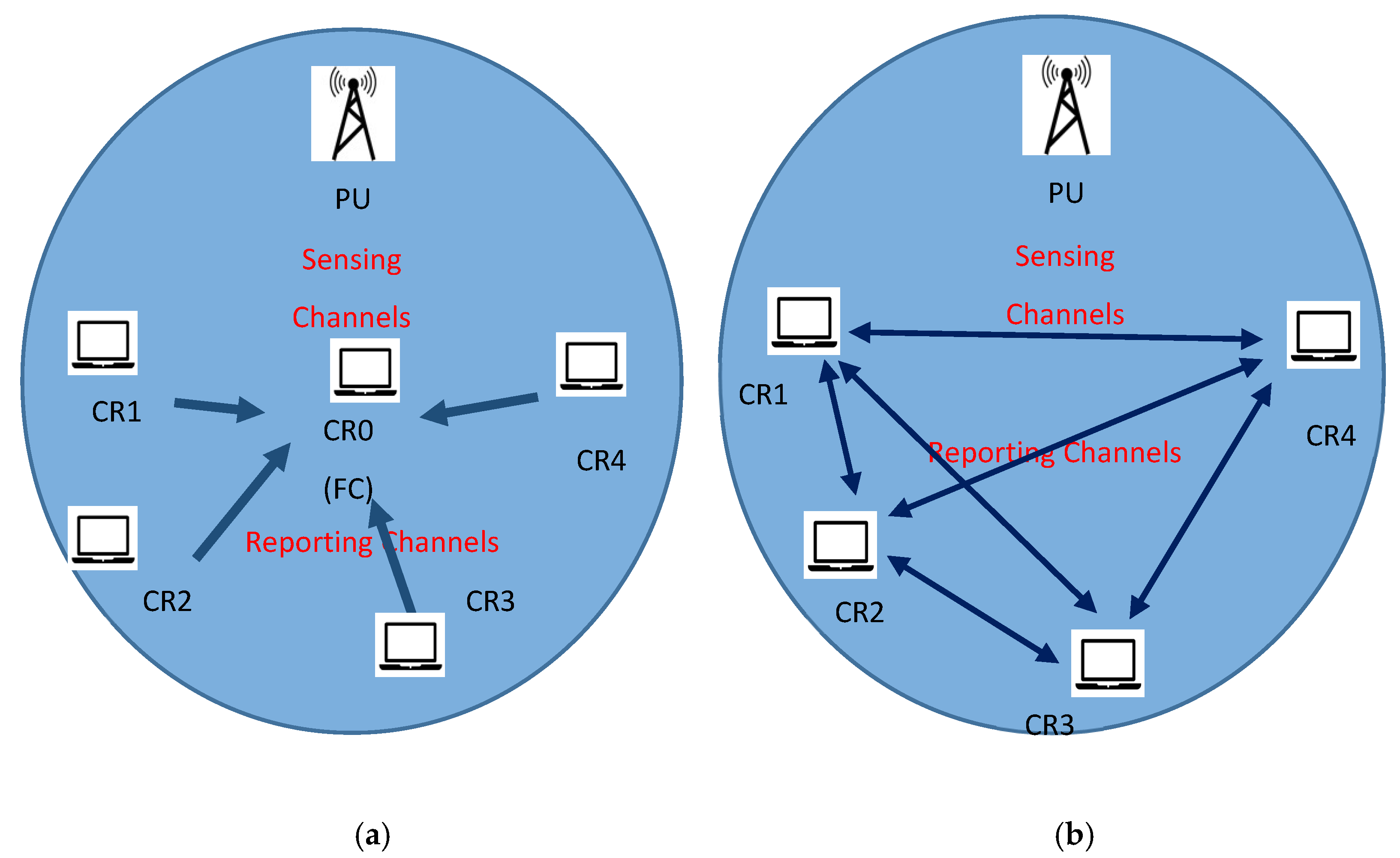
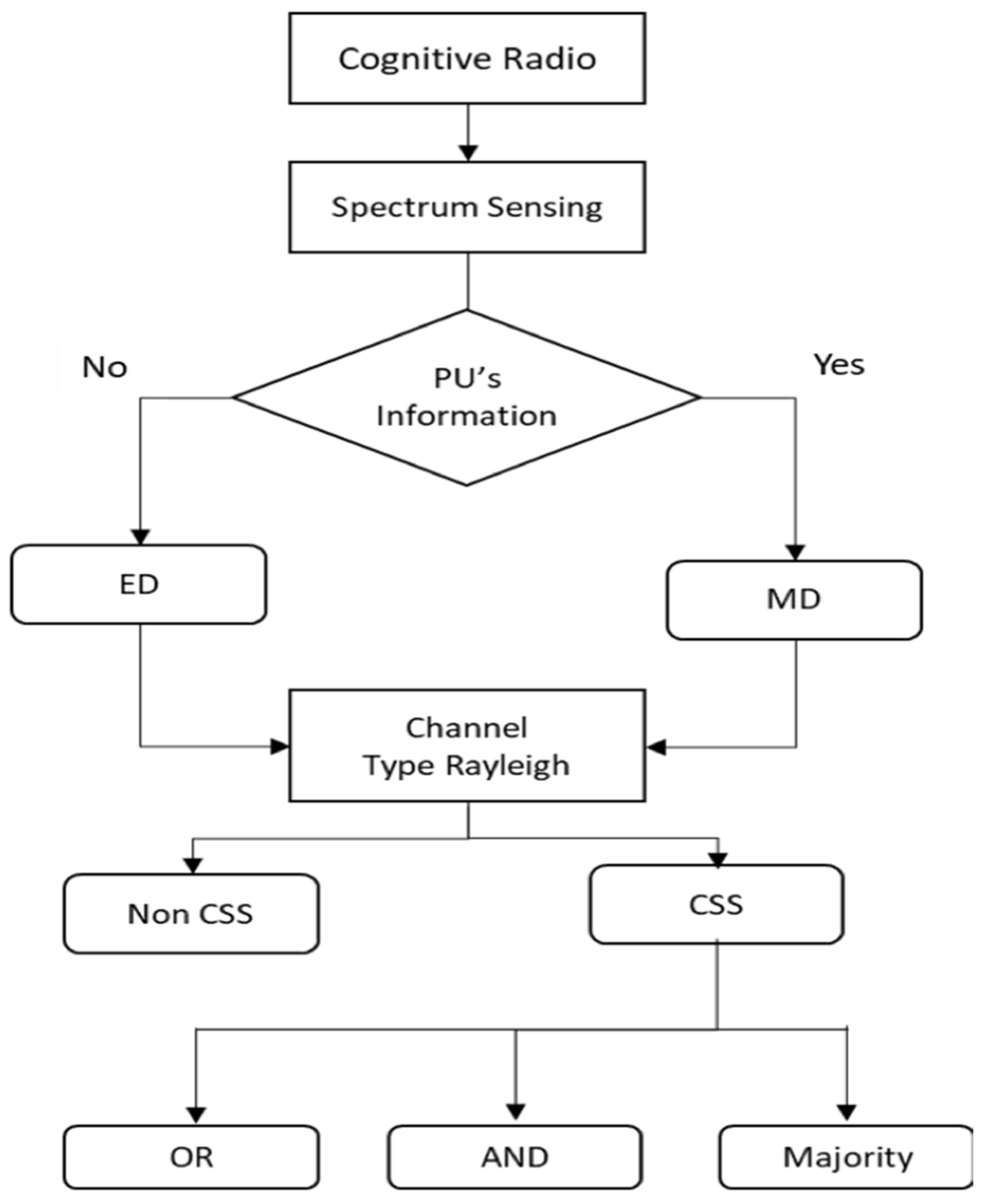
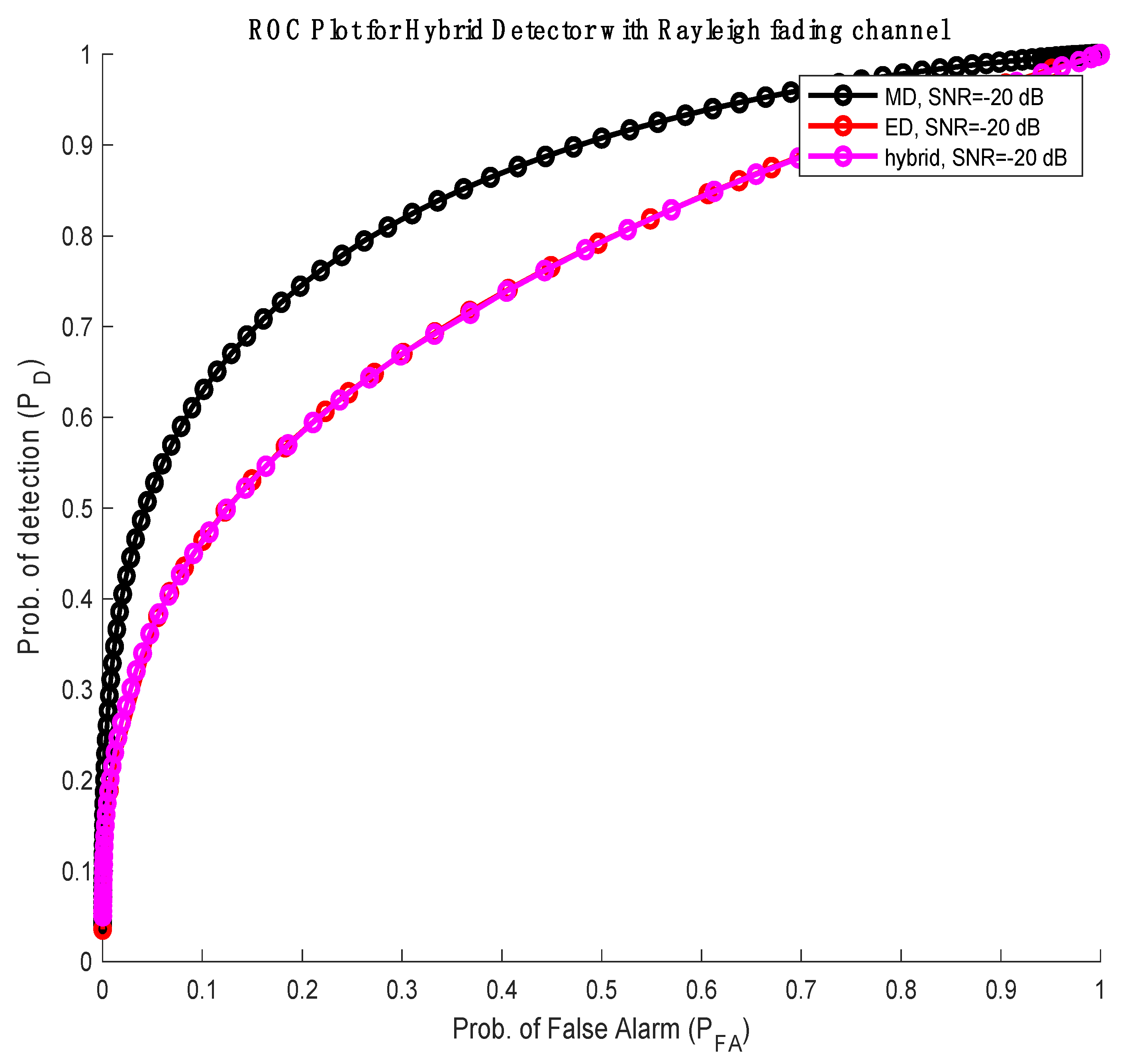
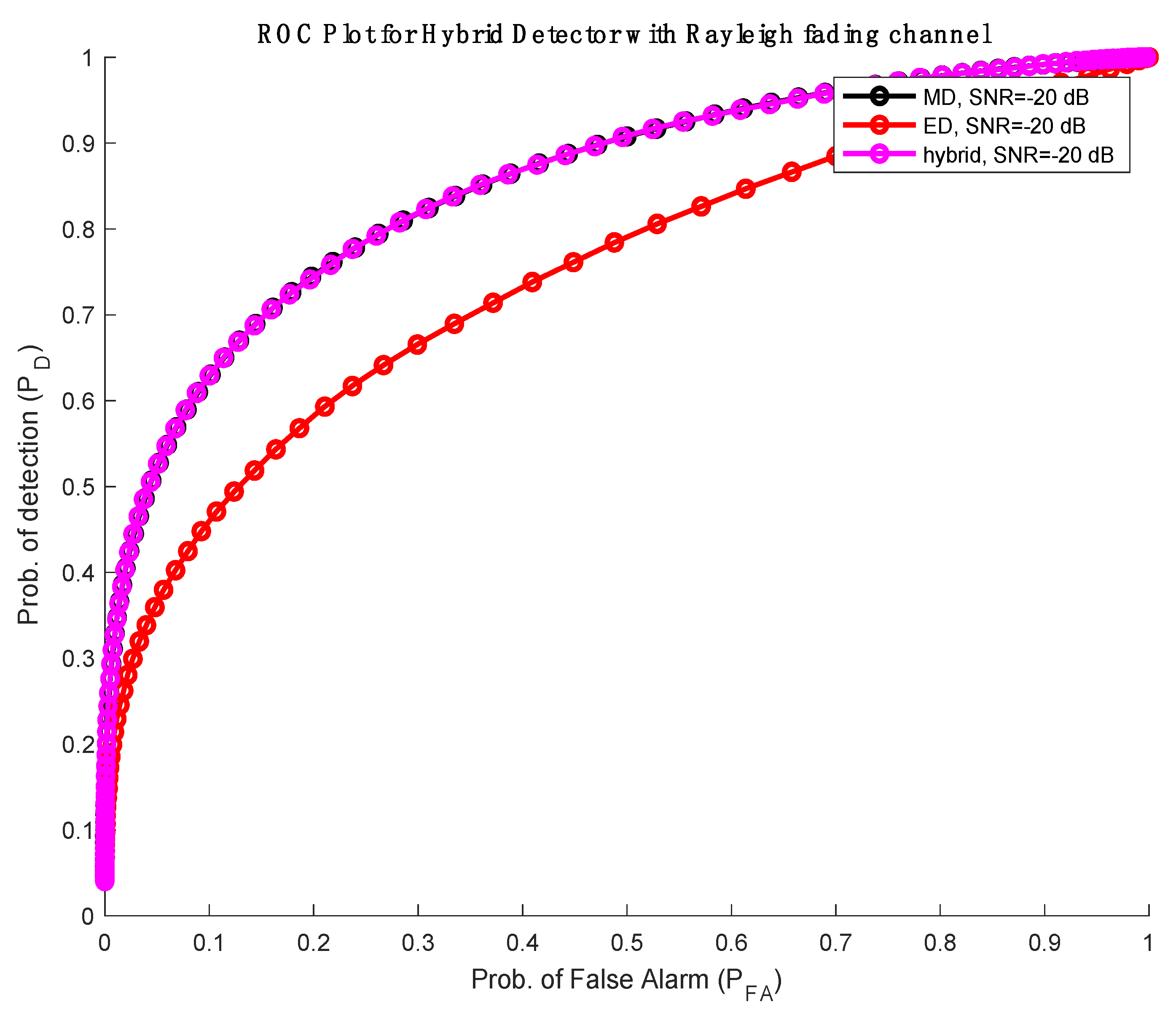


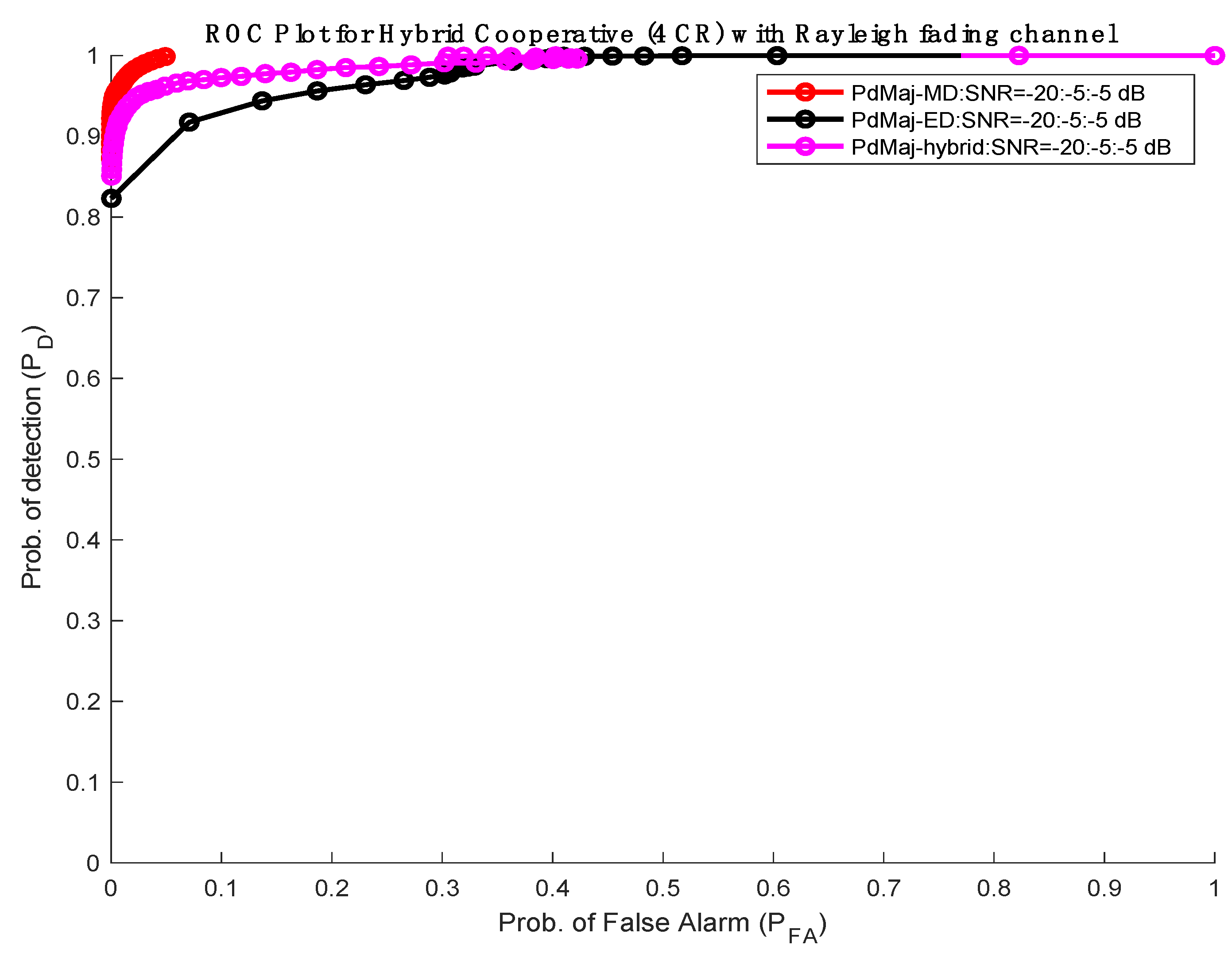
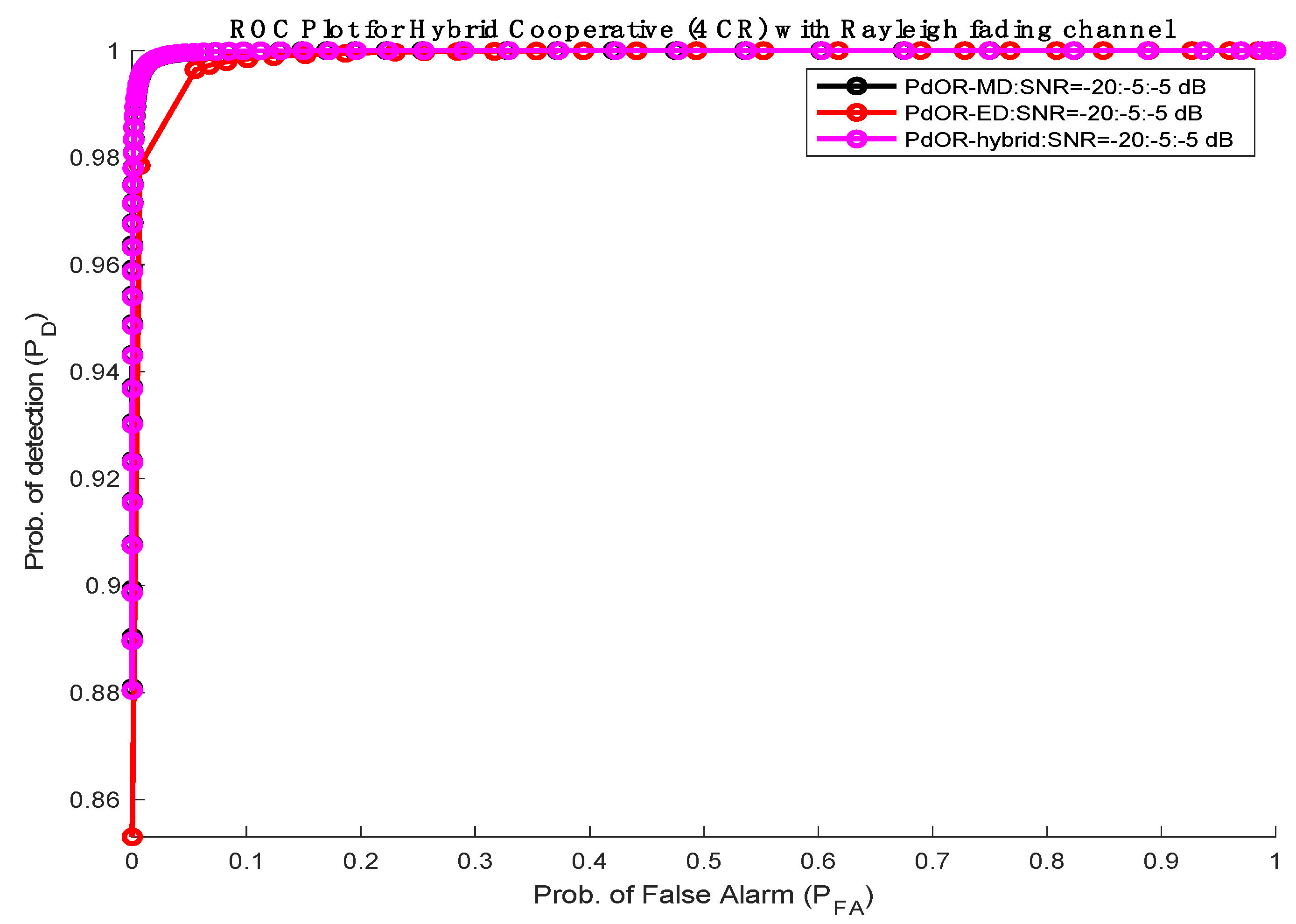
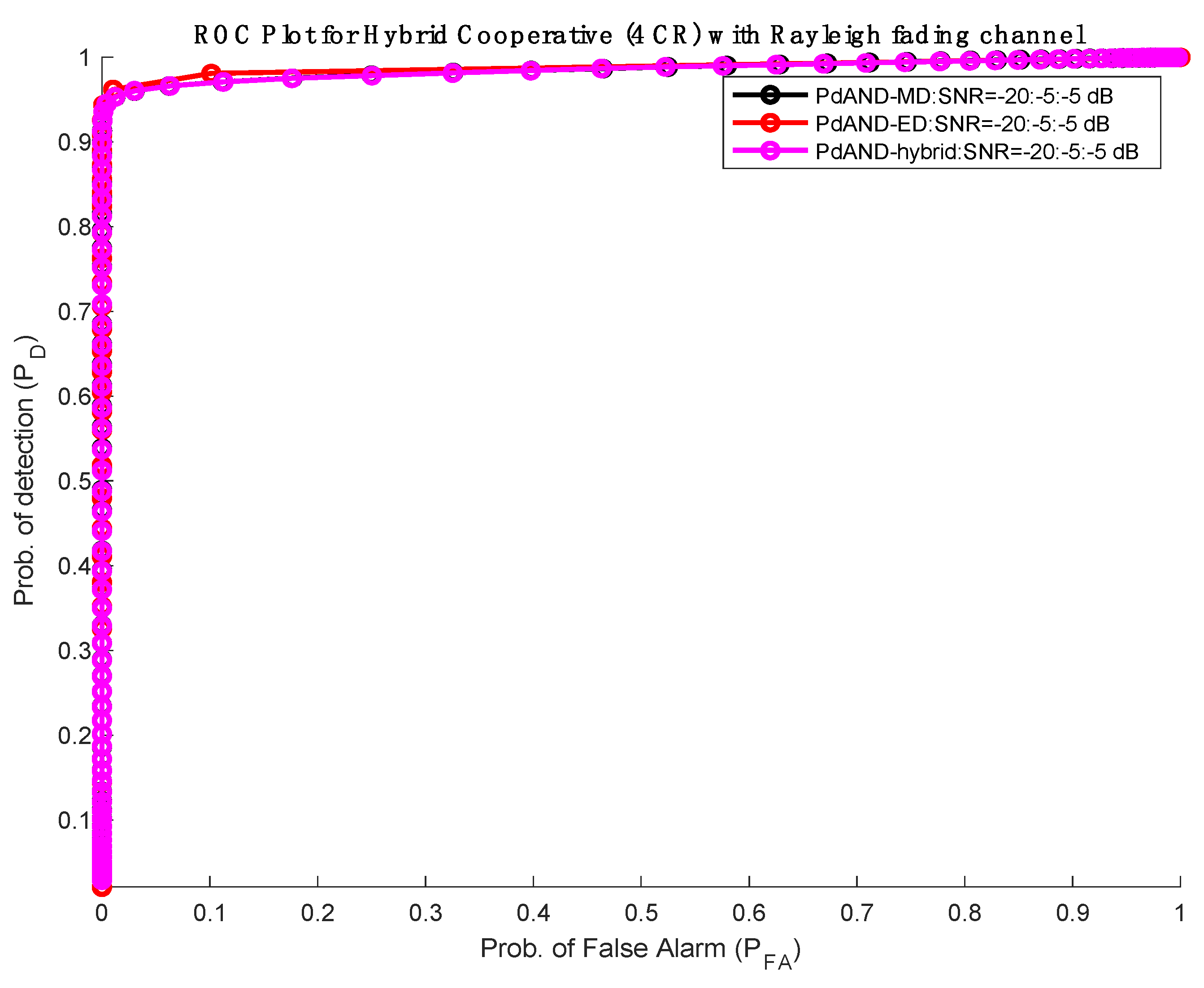

| Spectrum Sensing (SS) Technique | SNR in dB | Cooperative SS (CSS) Technique and No. of Users (M) | Sample Size (N) | Probability of Detection PD | Probability of False Alarm PFA |
|---|---|---|---|---|---|
| Efficient spectrum management techniques using adaptive ED [30] | −20 | No | 1000 | 0.6 0.58 | 0.01 0.1 |
| Efficient spectrum management techniques using adaptive MD [30] | −20 | No | 1000 | 0.54 0.55 | 0.1 0.01 |
| Enhanced energy detector using MD [34] | −10 −20 | No | 100 | 0.9 0.925 | 0.1 0.1 |
| Enhanced spectrum sensing based on energy detector [35] | −20 | No | 1000 | 0.4 | 0.01 |
| Fusion rule-based dynamic grouping [36] | −20 | Yes, M = 15 | 4000 | 0.97 | 0.1 |
| Case 1: Select ED | Non-CSS | Case 2: Select MD | Non-CSS |
|---|---|---|---|
| PD | 0.5 | PD | 0.6 |
| PFA | 0.1 | PFA | 0.1 |
| SNR (low range) | −20 dB | SNR (low range) | −20 dB |
| Case 1: Select ED | OR | AND | Majority | Case 2: Select MD | OR | AND | Majority |
|---|---|---|---|---|---|---|---|
| SNR (low range) | −20 dB, −15 dB, −10 dB, −5 dB | SNR (low range) | −20 dB, −15 dB, −10 dB, −5 dB | ||||
| Cooperative users (M) | 4 | Cooperative Users (M) | 4 | ||||
| PD | 0.98 | 0.96 | 0.94 | PD | 1 | 0.96 | 0.88 |
| PFA | 0 | 0 | 0.1 | PFA | 0 | 0 | 0 |
| Hybrid (SS) Technique | SNR Value in dB | Cooperative SS (CSS) Technique and No. of Users (M) | Detector Used | Probability of Detection PD | Probability of False Alarm PFA |
|---|---|---|---|---|---|
| The proposed hybrid detector (HD) model | −20 | Yes and 4 | ED and MD | 0.98 | 0 |
| Improvement in SS using Modified hybrid sensing [17] | 0 | Yes and 3 | MD and CFD | 0.82 | 0.001 |
| Hybrid Sensing for band selection [18] | −20 | Yes and 10 | ED | 0.65 | 0.1 |
| Complexity reduction for CFD using improved hybrid sensing [19] | 0 | Yes and 3 | CFD and sliding DFT | 0.7 | 0.1 |
Publisher’s Note: MDPI stays neutral with regard to jurisdictional claims in published maps and institutional affiliations. |
© 2022 by the authors. Licensee MDPI, Basel, Switzerland. This article is an open access article distributed under the terms and conditions of the Creative Commons Attribution (CC BY) license (https://creativecommons.org/licenses/by/4.0/).
Share and Cite
Bani, K.; Kulkarni, V. Hybrid Spectrum Sensing Using MD and ED for Cognitive Radio Networks. J. Sens. Actuator Netw. 2022, 11, 36. https://doi.org/10.3390/jsan11030036
Bani K, Kulkarni V. Hybrid Spectrum Sensing Using MD and ED for Cognitive Radio Networks. Journal of Sensor and Actuator Networks. 2022; 11(3):36. https://doi.org/10.3390/jsan11030036
Chicago/Turabian StyleBani, Kavita, and Vaishali Kulkarni. 2022. "Hybrid Spectrum Sensing Using MD and ED for Cognitive Radio Networks" Journal of Sensor and Actuator Networks 11, no. 3: 36. https://doi.org/10.3390/jsan11030036
APA StyleBani, K., & Kulkarni, V. (2022). Hybrid Spectrum Sensing Using MD and ED for Cognitive Radio Networks. Journal of Sensor and Actuator Networks, 11(3), 36. https://doi.org/10.3390/jsan11030036






